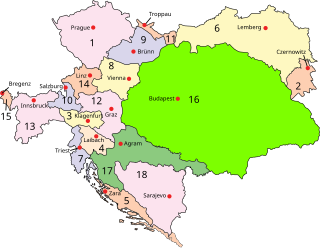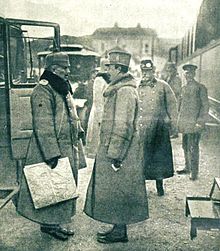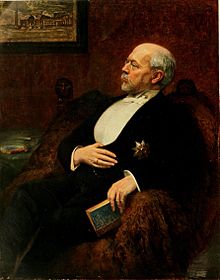
Austria-Hungary, often referred to as the Austro-Hungarian Empire or the Dual Monarchy, was a multi-national constitutional monarchy in Central Europe between 1867 and 1918. Austria-Hungary was a military and diplomatic alliance of two sovereign states with a single monarch who was titled both emperor of Austria and King of Hungary. Austria-Hungary constituted the last phase in the constitutional evolution of the Habsburg monarchy: it was formed with the Austro-Hungarian Compromise of 1867 in the aftermath of the Austro-Prussian War and was dissolved shortly after Hungary terminated the union with Austria on 31 October 1918.

The Austro-Hungarian Compromise of 1867 established the dual monarchy of Austria-Hungary, which was a military and diplomatic alliance of two sovereign states. The Compromise only partially re-established the former pre-1848 sovereignty and status of the Kingdom of Hungary, being separate from, and no longer subject to, the Austrian Empire. The compromise put an end to the 18-year-long military dictatorship and absolutist rule over Hungary which Emperor Franz Joseph had instituted after the Hungarian Revolution of 1848. The territorial integrity of the Kingdom of Hungary was restored. The agreement also restored the old historic constitution of the Kingdom of Hungary.

The Habsburg monarchy, also known as Habsburg Empire, was the collection of empires, kingdoms, duchies, counties and other polities that were ruled by the House of Habsburg. From the 18th century it is also referred to as the Danubian monarchy or the Austrian monarchy.

Ottokar Theobald Otto Maria Graf Czernin von und zu Chudenitz was an Austro-Hungarian diplomat and politician during the time of World War I, notably serving as Foreign Minister from 1916 to 1918.

Count Stephan Burián von Rajecz, commonly called: "Baron von Burian" or, later, "Count Burian" in English language press reports; (titles from 1900, Freiherr; from 1918, Graf) was an Austro-Hungarian politician, diplomat and statesman of Hungarian origin and served as Imperial Foreign Minister during World War I.

The Czechoslovak Declaration of Independence or the Washington Declaration was drafted in Washington, D.C., and published by Czechoslovakia's Paris-based Provisional Government on 18 October 1918. The creation of the document, officially the Declaration of Independence of the Czechoslovak Nation by Its Provisional Government, was prompted by the imminent collapse of the Habsburg Austro-Hungarian Empire, of which the Czech and Slovak lands had been part for almost 400 years, following the First World War.

The dissolution of Austria-Hungary was a major geopolitical event that occurred as a result of the growth of internal social contradictions and the separation of different parts of Austria-Hungary. The more immediate reasons for the collapse of the state were World War I, the 1918 crop failure, general starvation and the economic crisis. The Austro-Hungarian Empire had additionally been weakened over time by a widening gap between Hungarian and Austrian interests. Furthermore, a history of chronic overcommitment rooted in the 1815 Congress of Vienna in which Metternich pledged Austria to fulfill a role that necessitated unwavering Austrian strength and resulted in overextension. Upon this weakened foundation, additional stressors during World War I catalyzed the collapse of the empire. The 1917 October Revolution and the Wilsonian peace pronouncements from January 1918 onward encouraged socialism on the one hand, and nationalism on the other, or alternatively a combination of both tendencies, among all peoples of the Habsburg monarchy.
World War I began when Austria-Hungary invaded Serbia in July 1914, following the Assassination of Archduke Franz Ferdinand. Austria-Hungary was one of the Central Powers, along with the German Empire and the Ottoman Empire. Austro-Hungarian forces fought the Allies in Serbia, on the Eastern Front, in Italy, and in Romania. With heavy aid and support from its allies, the empire managed to occupy Serbia in 1915 and force Romania out of the war in 1917. On the other fronts, it suffered severe casualties, culminating in the collapse of the Italian front, which led the Austrians to accept the Armistice of Villa Giusti on 3 November 1918.
The Treaty of Peace between Austria-Hungary and Finland, also called the Vienna Peace Treaty, was signed in Vienna on 29 May 1918, bringing to an end the state of war that existed between Finland and Austria-Hungary as a result of World War I.
The Supreme War Command ; initially the Joint Supreme War Command was a military headquarters established on 7 September 1916 to exert command over all of the armed forces of the Central Powers in the First World War. The creation of the command had been discussed by German political figures by mid-1916 but was implemented at the request of Paul von Hindenburg and Erich Ludendorff, who were appointed to effective command of the Imperial German Army on 29 August. Germany's key ally Austria-Hungary was ambivalent on the matter but eventually agreed to the proposal on 3 September. The other two Central Powers, Bulgaria and the Ottoman Empire, formally agreed at a conference on 6 September and the OKL was established the following day.

The Hoyos Mission describes Austro-Hungarian Foreign Minister Leopold Berchtold's dispatch of his promising 38-year-old private secretary, Alexander Hoyos, to meet with his German counterparts. This secret mission was intended to provide Austro-Hungarian policy-makers with information on the Reich's intentions shortly after the assassination of Franz Ferdinand of Austria, the Imperial and Royal Kronprinz, in Sarajevo. On 5 July 1914, a week after the assassination attempt that claimed the lives of the heir to the throne and his wife, the Austro-Hungarian government sought to officially secure the Reich's support for the actions it wished to take against Serbia in response to the attack. Indeed, the initiatives of the Kingdom of Serbia, victorious in the two Balkan wars, prompted Austro-Hungarian officials to adopt a firm stance in the international crisis opened by the assassination of the Austro-Hungarian heir.

The Bellevue Conference of September 11, 1917, was a council of the German Imperial Crown convened in Berlin, at Bellevue Palace, under the chairmanship of Wilhelm II. This meeting of civilians and military personnel was convened by German Emperor Wilhelm II to determine the Imperial Reich's new war aims policy, in a context marked by the February Revolution and the publication of Pope Benedict XV's note on August 1, 1917; the question of the fate of Belgium, then almost totally occupied by the Reich, quickly focused the participants' attention. Finally, this meeting also had to define the terms of the German response to the papal note, calling on the belligerents to put an end to armed confrontation.

The Berlin Conference of August 14, 1917, was a German–Austro-Hungarian diplomatic meeting to define the policy of the Central Powers following the publication of the Papal Note of August 1, 1917. Since April of the previous year, the Reich government members sought to impose unrealistic war aims and to require their Austro-Hungarian counterparts, who were governing a monarchy drained by the prolonged conflict, to share the European conquests of the Central Powers. The objective was to bring the dual monarchy under strict German control.

The Kreuznach Conference on August 9, 1917, was a German government conference that aimed to draft the Reich Government's response to the proposals made on August 1, 1917, by Austro-Hungarian Foreign Minister Ottokar Czernin for negotiating an honorable way out of the conflict. Additionally, the conference served as the primary meeting between the new Imperial Chancellor, Georg Michaelis, and the two main leaders of the German High Command, Erich Ludendorff and Paul von Hindenburg. At this meeting, the military tried to impose the war aims they set for the conflict on the members of the civilian government, based on the minutes of the April 23, 1917 conference.
During World War I, a conference took place between the German emperor Wilhelm II and the Austro-Hungarian monarch Charles I in Spa on 12 May 1918. At his meeting, Charles I and his minister Stephan Burián von Rajecz were forced to accept the political and economic subjection of Austria-Hungary to the German Empire in the form of a treaty. Formally concluded on an equal footing between the signatory powers, the agreements reached at Spa in fact endorsed the pre-eminence of Germany and guaranteed its supremacy, while the Austro-Hungarians were forced into a situation of political, economic and military dependence. However, the Spa agreement, which made the dual monarchy subject to an "Austro-German Zollverein", failed to put an end to rivalries in the Balkans and Eastern Europe, or to political disagreements over the end of the conflict or the future of occupied Poland. At the meeting on May 12, German and Austro-Hungarian negotiators agreed to set up technical commissions to put into practice the economic and commercial provisions of the agreement in principle between the emperors. The subsequent Salzburg negotiations, however, fell apart in October with the imminent defeat of Germany and Austria-Hungary.

The Berlin Conference of March 26–27, 1917 was the second governmental meeting between Arthur Zimmermann and Ottokar Czernin, the German and Austro-Hungarian foreign ministers, under the chairmanship of Reich Chancellor Theobald von Bethmann Hollweg. The meeting was intended to define the war aims of the Imperial Reich and the Dual Monarchy, and to prepare for the first official meeting between German Emperor Wilhelm II and the new Emperor-King Charles I. At a time when changes in political personnel were taking place in the Dual Monarchy, which was becoming increasingly exhausted by the protracted conflict, this meeting was the first sign of disagreement between the two allies over the conditions for ending the conflict.

The Berlin Conference, held from November 2 to 6, 1917, consisted of a series of meetings between German and Prussian ministers, followed by meetings between German and Austro-Hungarian representatives. The conference was held in Berlin just a few days before the outbreak of the October Revolution. At the same time, the antagonisms between Chancellor Georg Michaelis, supported by State Secretary Richard von Kühlmann, on the one hand, and the military, mainly the Dioscuri, Paul von Hindenburg and Erich Ludendorff, on the other, reached a climax, prompting the military to call for the Chancellor's resignation, formalizing their disagreements over the program for internal reform of the Reich. These differences between political and military leaders also had at stake the definition of a new program of war aims for the Reich, and the concessions the Germans would be prepared to make to their allies, principally the Dual Monarchy, exhausted by more than three years of conflict, but hostile to any excessive reinforcement of German control over Central and Eastern Europe.

The Vienna Conference of August 1, 1917 was a German-Austro-Hungarian governmental conference designed to regulate the sharing of the quadruple European conquests, against a backdrop of growing rivalry and divergence between the Imperial Reich and the Dual Monarchy. Convened at a time when the dual monarchy was sinking into a crisis from which it proved unable to emerge until the autumn of 1918, the Vienna meeting was a further opportunity for German envoys to reaffirm the Reich's weight in the direction of the German-Austrian-Hungarian alliance, on the one hand, and in Europe, on the other.

















